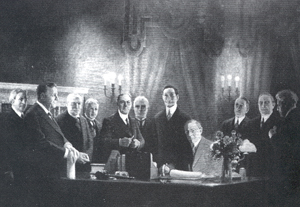The economic history of the Southeast and the development of Atlanta as a financial center were profoundly changed by the low-key opening, on November 16, 1914, of the Federal Reserve Bank of Atlanta. Shifting political winds had dictated that the United States would have not one central bank located in the capital-heavy Northeast, but twelve, dispersed around the country. The deep South, probably the least "federal" region of the country in the early twentieth century, would have its own Fed—a southern, federal bank.
 |
| President Woodrow Wilson signs the 1913 Federal Reserve Act, establishing the Federal Reserve System. This painting by Wilbur G. Kurtz, Sr., was commissioned by the Atlanta Fed in 1923 and now belongs to the Woodrow Wilson Birthplace Foundation in Staunton, Virginia. |
A decentralized central bank is paradoxical, and the Atlanta Fed struggled at times with its mandate to serve both national and regional interests.
But it was, particularly at first, a very southern institution, staffed and led by southern bankers and businessmen, sensitive to the vicissitudes of "King Cotton," and ready to bolster and stabilize the agrarian economy of the region. It sent roots throughout its district, creating the first, the last, and the most branches of any Federal Reserve Bank. It provided a stable source of funds and a high set of standards to an impoverished regional banking system that needed both. It became a clearinghouse of checks but also of economic facts, spreading information and nurturing progress.
And it was, particularly in times of crisis, a very federal institution. It brought a national purpose and cooperative role to efforts to finance an immense "world" war, to weather an unprecedented depression, to finance an even more cataclysmic war, and to control an explosive postwar economy that staggered through inflationary outbursts and acute social demands. The Atlanta Bank came, in time, to be the national standard setter in one of the least regional of banking activities—electronic funds transfer—and the most efficient, best-engineered money processing factory in the nation.
It grew with the times, sometimes struggling to understand and manage the surprising circumstances into which it was thrust, sometimes providing the vision and leadership to direct an orderly advance. It was tightly regulated, a countinghouse that ran by strict rules. But it also was a magnet that attracted forceful, farsighted, ambitious leaders who brought color, conflict, and humor to its walls. Much that it did was routine, and yet its history is characterized by crisis, aspiration, loyalty, and a sometimes stumbling but relentless progress toward discovering its own role. To depict the Bank's first 75 years, this history combines material from official records with the firsthand recollections of its people. Those directors, officers, and staff members, as well as economic and technical changes, have shaped the Bank. And the Bank, in turn, has moved to shape events to advance an economic vision that has lifted both the region and the nation in a story that continues to unfold.
| Previous | Next |



